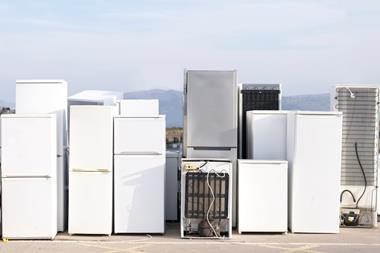A top down analysis of atmospheric HFC-23 suggests that countries are releasing up to 140 per cent more than they are reporting
Chemical companies in Europe are failing to report in full their emissions of HFC-23, an extremely potent greenhouse gas. The evidence suggests that actual emissions from countries in Europe are 60-140 per cent higher than reported.HFC-23, which is CHF3 (fluoroform), has a 100 year global warming potential about 14,800 times greater than that of CO2. Almost all HFC-23 released today is waste from the production of CHClF2 (HCFC-22 or chlorodifluoromethane), used as a refrigerant and a precursor in the production of a range of fluorinated compounds, including polytetrafluoroethylene (PTFE), more commonly known by its DuPont trade name, Teflon.
Under EU rules, chemical companies do not have to destroy HFC-23. But member states that have signed up to the Kyoto agreement are obliged to report their emissions - and they rely on emissions data from companies to do this.
Researchers from the Swiss Federal Laboratories for Materials Science and Technology (EMPA) in Duebendorf mapped estimated emissions from across Europe using 2008-2010 measurements of atmospheric HFC-23 gathered in two locations: Jungfraujoch in Switzerland and Mace Head in Ireland. They then compared this map with reported emissions, which were generally much lower. The results suggest that Italy, for example, has been emitting 10-20 times more HFC-23 than reported.
Clare Perry from the Environmental Investigation Agency (EIA), a UK charity, said it was ’scandalous’ given the ’vast profits’ enjoyed by fluoro-chemical companies. The EIA says that HFC-23 can be destroyed for just €0.17 (?0.15) per tonne of CO2 equivalent, and it is calling for a universal ban on the release of HFC-23.
Companies can destroy HFC-23 by incineration or with a plasma torch that induces pyrolysis in inert atmospheres with temperatures of up to 20,000?C. US company Plascon, for example, has installed equipment at several HCFC-22 plants that uses plasma to converts HFC-23, plus small amounts of water and oxygen, into carbon dioxide and hydrogen fluoride, which is quenched with sodium hydroxide. It says the process is 99.9999 per cent efficient.
A lingering issue
The research is potentially embarrassing for Belgian chemical company Solvay, which, according to the EMPA, owns the ’sole HCFC-22 factory west of Milan’, the Solvay Solexis plant at Spinetta Marengo. Company spokesperson Erik De Leye said Solvay was investigating the difference between estimates from the EMPA group and the reported data. He confirmed that the Spinetta Marengo plant has an incinerator dedicated to eliminating HFC-23. Cefic (the European Chemical Industry Council) declined to comment.
HFC-22 has been a policy hot potato before. In 2010, environmental groups petitioned the EU to change elements of its Emissions Trading Scheme (ETS). At the time, companies in developing countries could earn credit for HFC-23 elimination projects - credit that could be sold on the ETS market. But this was so profitable that companies were overproducing HCFC-22 just to destroy the HFC-23. In January, EU member states voted in favour of halting the practice, which they described as a ’perverse incentive’.
Andrew Turley
References
C A Keller et al, Geophys. Res. Lett., 2011, DOI: 10.1029/2011GL047976







No comments yet